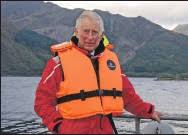£1m project aims to save wild salmon

A PROJECT aimed at trying to halt the decline in wild salmon stocks was launched this morning on the River Garry in the Scottish Highlands.
The Missing Salmon Project will track scores of fish in an attempt to uncover what has caused populations to drop by 70 per cent in the past 25 years.
And with global populations of wild Atlantic salmon declining from eight to ten million in the 1970s to three to four million fish today, it is hoped the project will have an international impact.
The two-year scheme, launched by the Atlantic Salmon Trust (AST), will study salmon in the Moray Firth on Scotland’s east coast.
The executive director of the AST, Sarah Bayley Slater, said: ‘Salmon have been around for more than 60 million years, but their future looks very bleak indeed.
‘If the decline we’ve seen across the Atlantic and in Scotland continues, the wild Atlantic salmon could be an endangered species in our lifetime.
‘In launching the Missing Salmon Project, we are making our stand now and giving our generation a chance to save the species before it’s too late.’
The AST, whose patron is Prince Charles, is preparing a wider Suspects Framework, which identifies and aims to quantify the causes for salmon mortality on their journey from river to sea and back again.
The Missing Salmon Project, part of the Suspects Framework, is looking to raise £1 million – including by crowd funding – to pay for the tags and the acoustic receivers that track the salmon’s journey.
Dr Matthew Newton, tracking coordinator for the AST, said: ‘If we’re going to have a meaningful impact on reversing the Atlantic salmon’s decline, we need to tag and track fish on a scale never seen before in Europe.
‘By tagging the fish and tracking their progress from their spawning ground and back again, we’ll be able to pinpoint where fish are being lost – and help identify the causes for their increasingly worrying mortality rates.’
The Missing Salmon Project will tag smolts as they begin their journey from their home river towards the sea.
Salmon are recorded as they pass through strategic points – which will help determine how many fish make it to the ocean and where mortality occurs.
The tracking project will start in the Moray Firth, where 20 per cent of all salmon that leave the UK originate, and the lessons learned will be transferable to other populations of salmon around the UK.
In a separate study, the Scottish government is investing £700,000 to address the decline of wild salmon stocks.
The money will include £500,000 for research and activities, and includes a new national programme of local sampling.
This will help to count the numbers of juvenile salmon in rivers, before they leave to become adults at sea and return, and monitor their abundance.
District Salmon Fishery Boards (DSFBs) and those interested in establishing new DSFBs can also bid for a share of £200,000 for mergers, or to set up new boards which will help improve the efficiency and effectiveness of fisheries management.
Environment Secretary Roseanna Cunningham said: ‘The decline in wild salmon numbers is due to a range of complex factors and is of great concern – we must do all we can to safeguard the future of this iconic species.
‘The survival rate of salmon during their marine phase has fallen from around 25 per cent to five per cent over the last 40 years and, while the exact causes of this dramatic loss are unclear, we must do what we can to protect salmon numbers.’
To find out more about the Missing Salmon Project, and to donate to the cause, visit www.crowdfunder.co.uk/themissingsalmonproject
Picture: Prince Charles, patron of the Atlantic Salmon Trust

